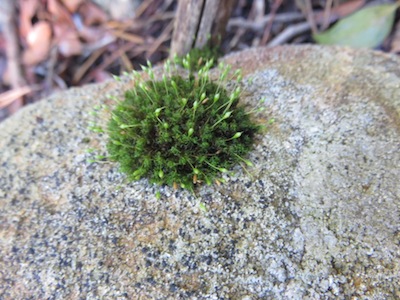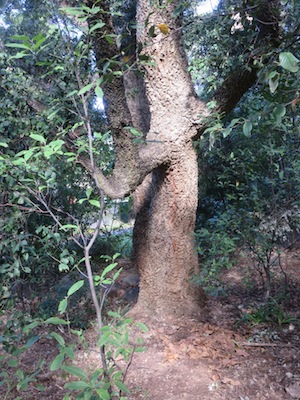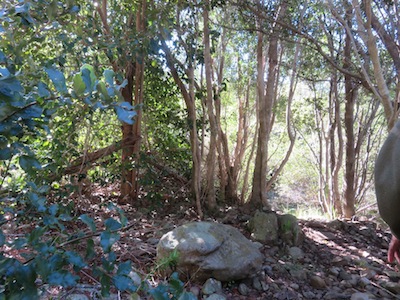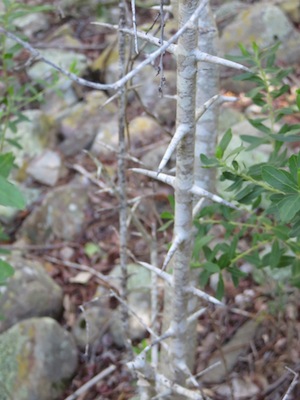Dear Reader, in this age of AI created content, please support with your goodwill someone who works harder to provide the human-made. Sign up at the top of the lefthand column or bottom of this page. You will receive my hand illustrated monthly newsletter RESTORE NATURE and access to the biodiversity garden design course as I write...and nothing else, I respect your time. I am also removing the advertizing as best I can as its become intrusive inappropriate and pays me nothing.
A forest ecosystem project:
forest regeneration
Our very own
forest ecosystem project:
the players
I started my own forest ecosystem project on Sunday 27 June 2017. I went up into the forest on Table Mountain with my mom. She is 86 and I'm trying to keep alive her memories of her thirty years as a green activist, in which
she first compiled lists of plants growing on the scrubby dry west coast, and then fought to protect the indigenous Afro-montane forest on Table Mountain and started a wild tree nursery. During the process she met other forest activists from this continent, from Kenya, who were also fired up about protecting our African forests, as well as forest ecologists from Europe who studied our forests and provided regeneration guidelines.
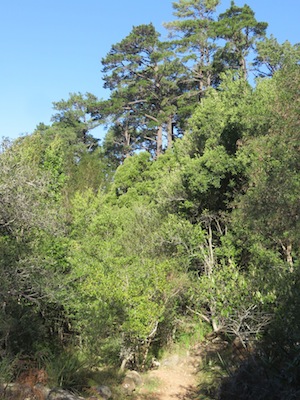 the observation station for our forest ecosystem project, the pocket forest seen from the outside, dwarfed by pines
the observation station for our forest ecosystem project, the pocket forest seen from the outside, dwarfed by pinesI am an eco blogger and I'm working with my mother on the future project of my dreams as a gardener: teaching the people of South Africa how to recreate the lost vegetation of our glorious Cape Floral Kingdom in home gardens, school and library gardens.
The purpose of our trip
into the forest
My mother wanted to show me a forest pocket that she believed I would find particularly instructive in my current trajectory of developing green ideas. This is my first baby step in trying to accomplish the goal of making knowledge about forest regeneration popular and start not just one but a regenerating forest ecosystem project at every public building in the Cape.
The ecology of
this part of the forest
 our forest pocket's "soil", with Chasmanthe spears
our forest pocket's "soil", with Chasmanthe spearsThe soil
We walked up to a boulder field, or a wash, of fist sized pebbles which may have been deposited after a storm. The forest grows here on a sea of small boulders. I will include very perfunctory and initial observations, which may be useful all around the world to people wanting to establish forest on boulder or pebble deposits especially in Mediterranean regions. The soil between the rocks is scant, and reddish and sandy, degraded shales which have washed down.
My mother's forest ecosystem project and the area around
the regenerated pocket forest
This pocket forest is one site of a series located on an educational trail called the Littlewort Trail, for which my mom wrote a guide many years ago. The area is a mix of alien forest trees planted during the colonial era, indigenous trees planted more recently, but without sound ecological principles, as the knowledge was not then available, some recent plantings after the input of more knowledge into forest regeneration, and forest that has regrown all on its own. It is a kind of laboratory of forest regeneration, and has been used as a locality for many a school forest ecosystem project, though my mom doesn’t take out school tours anymore. She remembers the joy it gave her to show enthusiastic learners who had never been in the forest, what a wonderful rich and complex thing it was. She did all of this without any financial reward, and has never put all her knowledge down on paper, and I hope to accomplish some of this recording, if I have not left it too late.
Description of the regenerated forest grove
This grove shows how a forest can regenerate from open shrub land. During recorded history, the whole area was stripped of trees. The multi-stemmed trees have formed an over canopy well above head height, with ‘curtains’ of foliage coming down to the ground, so that the open space on the interior of the grove has a sheltered microclimate, with more stable humidity, constant half shade, and humus from dropping leaves, constituting a little, sheltered forest ecosystem.
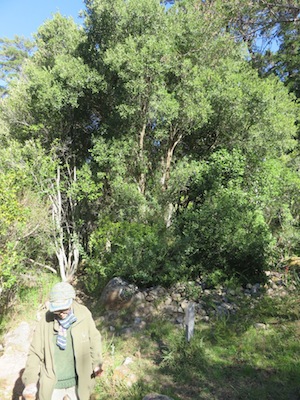 my mother near the curtain of plants on the sunny side
my mother near the curtain of plants on the sunny sideThe canopy roof and curtains
The little grove consists mostly of Olinea ventosa, a canopy tree in the Afromontaine forest.
Growing in the sunny north and west ‘curtains’ are Assegaaihout (Curtisia dentata) and wild peach Kigeleria africana and various legume family shrubs, Polygala, Podalyria and Muraltia, and a leguminous vine, Dipogon lignosis. Distributed all over the forest under the canopy and in surrounding open areas is thorny Cantheum inerme and C. mundianum. The edge of the canopy also
contains a Virgilia divaricata, an introduced variety of Vergilia. The importation of plants from the rest of South Africa has left behind the pollinators and many of these trees have never produced seed, which is good in a way. However the Virgilias do not have this problem, and are everywhere in this part of the forest.
In the shade of the Olinea trees were the dark glittering leaves of several shade tolerant ebony (Diospyros whyteana) and a boekenhout (Rapanea) sappling, waiting for the day when they will be able to spring up to become tall trees. This may take a break in the canopy, in the meantime they survive in the shade. On the margins of the canopy were a few Olea seedlings which are not so shade tolerant.
How did the forest
start regenerating ?
The trees are quite old, more than fifty years, so that my mother could not observe how it regrew, but has some theories. The Cantheum was never planted according to forestry records. So it must have started here as seed deposited by birds. Cantheum inerme has wonderful fruit, its common name is Cape date. The thorns on the young stems prevent it being grazed off, so that it is a good starter tree. Vergilia is always cited as a starter tree or pioneer because of its nitrogen fixing properties, but my mother has doubts about its singular status as a pioneer in this case, as Vergilia divaricata is an introduced variety and the introduction was too recent for it to have been the progenitor of this forest pocket.
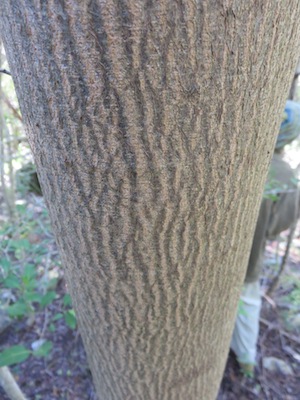 Sometimes the trees leaves are to high to use for identification and the bark is a good substitute. The bark of Vergilia divaricata.
Sometimes the trees leaves are to high to use for identification and the bark is a good substitute. The bark of Vergilia divaricata.What is different to
plantation plantings ?
The distance between trees is of vital importance. In early reforestation efforts the trees were planted very far apart, based on their full grown size. They have remained stunted for decades. The self established forest has trees much closer together. Most are 20-50cm apart, though this can vary to as much as 2 m. Definitely much closer than the 10 m average of the human reforestation efforts.
There are a diversity of legumes (5) one tree, one vine, and three bushes. These should not be forgotten in the recreation of the forest as they fix nitrogen in a way that suits the other trees, with which they have co-evolved.
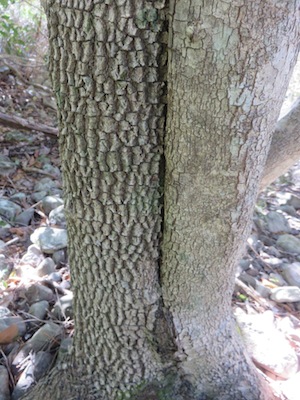 Olinea ventosa bark, old is wrinklier, young bark smooth
Olinea ventosa bark, old is wrinklier, young bark smoothIn the sheltering microclimate are three kinds of wild asparagus. My mom also remarked on the slow regrowth of forest microflora, lichens and moss, after the closure of the pocket’s small canopy.
An activist for reforestation, and an ex industrial engineer, has developed a rapid reforestation technique he is promoting throughout the world. He has reestablished tropical forests in ten years. His technique involves very close planting. There is a link below.
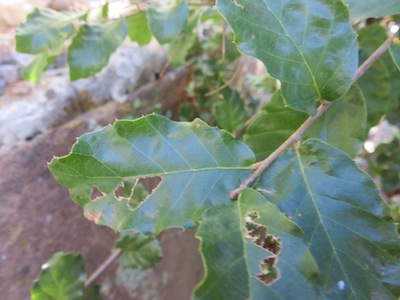 Quercus suber growing under the pocket forest canopy
Quercus suber growing under the pocket forest canopyWhat of the aliens ?
The forest contains aliens, wattles (Acacia longifolia) and vicks plant, highly invasive hawthorne (mixed varieties) and Lantana camara, which have been introduced by birds from gardens in the area. It is dotted with emerging Pinus saplings, and also contains a small cork oak tree, due to the proximity of the mother trees. The cork oak has established itself in this pile of rocks. I hope this encourages anyone wanting to reestablish cork oak or pine forest, the original forest dominants of the Mediterranean. There are a lot of squirrels, they may have helped.
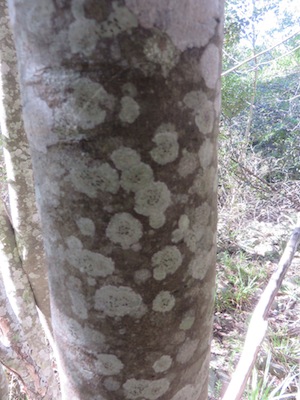 Lichens on also take hold on tree bark
Lichens on also take hold on tree barkideas for a forest
ecosystem project
Recording the appearance of the bark of different trees with photos taken by cellphones for identification purposes
Comparison of the odour of the trees for identification
Collecting and pressing leaves for a mini herbarium
Recording what lichens and moss grows all by itself on the rock mulch and tree bark in a shady planted area of the school garden. Observe these under a microscope.
Regeneration of your own forest as described below
Recording the regeneration process by multiple generations of schoolchildren
Growing your own forest micro-organisms from a teaspoon of forest soil
 My mum with her other children, two yellow-woods she close planted in the forest using free root planting
My mum with her other children, two yellow-woods she close planted in the forest using free root plantingList of trees for your
forest ecosystem project
on regeneration
Here is a list of the native plants in the forest pocket. Many of
them are available at nurseries in our region. Googling their botanical names can help find stockists. If you want to establish a
pocket forest as a forest ecosystem project, it
only needs an area of about 25 square metres, and a few decades. You can write
to Kirstenbosch to find out about funding and plants. The soil is Renosterveld soil,
degraded shales.
Trees
Curtisia dentata (Assegaai)
Cantheum inerme
Cantheum mundianum
Vergilia divaricata
Rapanea melanophloeos (boekenhout)
Maytenus oleoides
Olea europea-africana
Diospyros whyteana (ebony)
Emergent tree legume
Vergilia divaricata
sunny side legume shrubs
Podalyria calyptrata
Polygala myrtifolia (false pea)
Shade tolerant legumes
Muraltia
Dipogon lignosis
ground covers, bulbs and vines
Asparagus wild, three varieties can’t be identified
Dipogon lignosis
Blechnum australe (fern)
Chasmanthe floribunda ? / ethiopica ? (geophyte)
Myrsine africana (Bloubessiebos)
Microflora
Moss
Numerous lichens
Forest microflora are not available commercially and may not even be named as there are few projects for identifying them. Please do not harvest them in the wild off trees and rocks, they can take centuries to regrow. Turn it into a project to keep records and see what grows by itself and how long it takes to emerge.
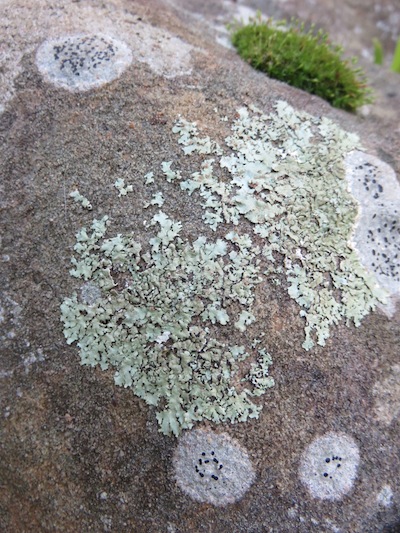
Planting and microflora propagation instructions will be printed in a later article
------
Home page for lots of information on eco friendly gardening
------
Natural garden design, recreating ecosystems
------
an album with more pictures of our trip to the forest
------
writing by a globally famous forest rehabilitation expert Shubhendu Sharma
Restore Nature Newsletter
I've been writing for four years now and I would love to hear from you
Please let me know if you have any questions, comments or stories to share on gardening, permaculture, regenerative agriculture, food forests, natural gardening, do nothing gardening, observations about pests and diseases, foraging, dealing with and using weeds constructively, composting and going offgrid.
Ask us ?
If you have any questions please let us know !
SEARCH
Order the Kindle E-book for the SPECIAL PRICE of only
Prices valid till 30.09.2023
Recent Articles
-
garden for life is a blog about saving the earth one garden at a time
Apr 18, 25 01:18 PM
The garden for life blog has short articles on gardening for biodiversity with native plants and regenerating soil for climate amelioration and nutritious food -
Cape Flats Sand Fynbos, Cape Town's most endangered native vegetation!
Apr 18, 25 10:36 AM
Cape Flats Sand Fynbos, a vegetation type found in the super diverse Cape Fynbos region is threatened by Cape Town's urban development and invasive alien plants -
Geography Research Task
Jan 31, 25 11:37 PM
To whom it may concern My name is Tanyaradzwa Madziwa and I am a matric student at Springfield Convent School. As part of our geography syllabus for this
"How to start a profitable worm business on a shoestring budget
Order a printed copy from "Amazon" at the SPECIAL PRICE of only
or a digital version from the "Kindle" store at the SPECIAL PRICE of only
Prices valid till 30.09.2023
